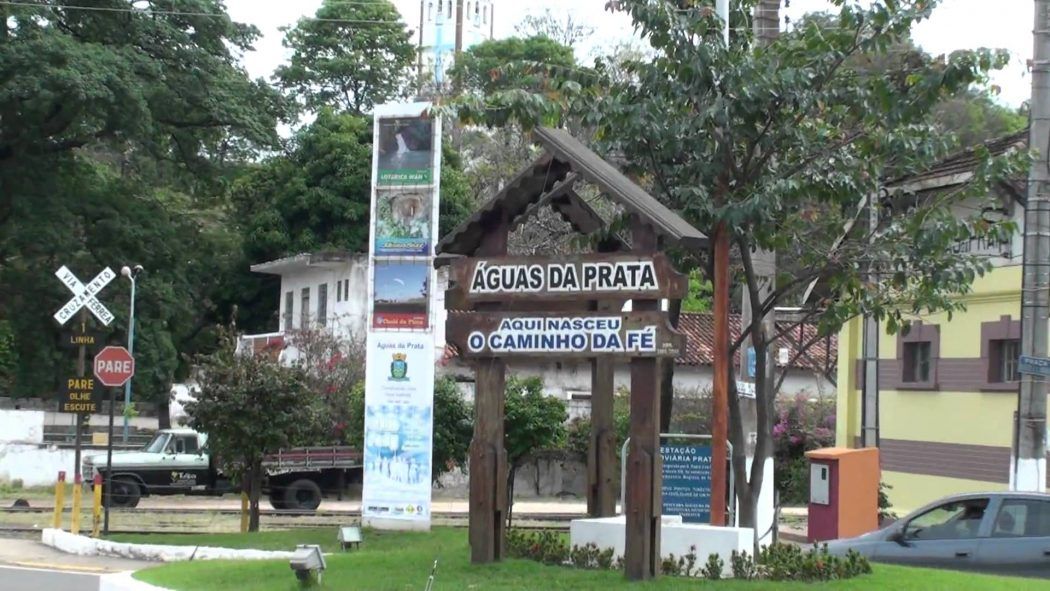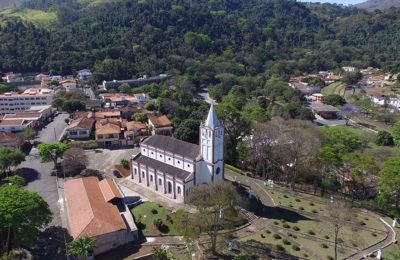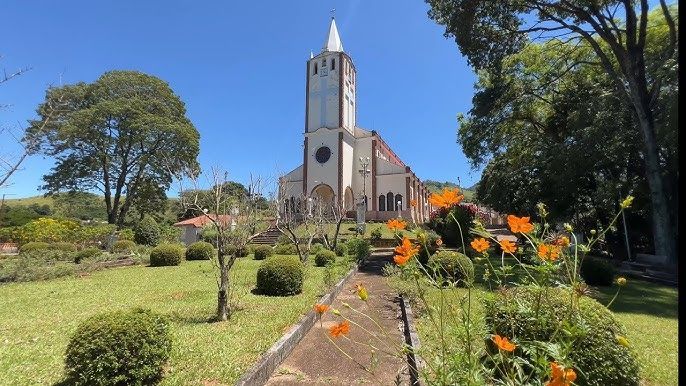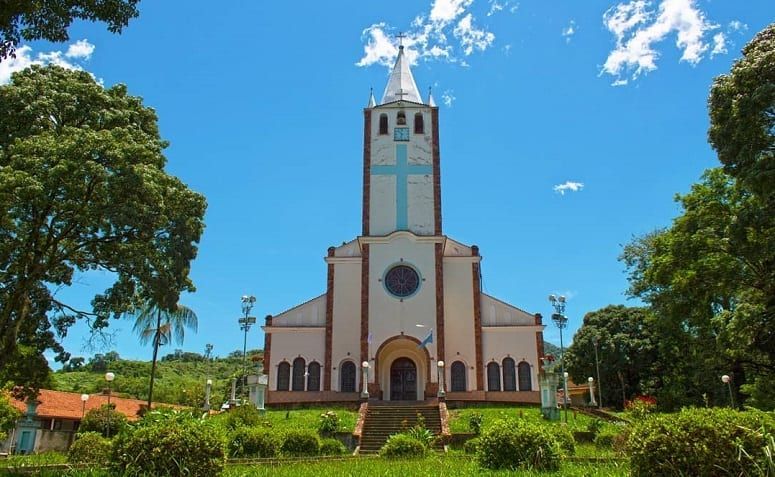Silver Waters - SP
On this page, the Pilgrim Portal of Hope presents the city of Águas da Prata, the beginning of the Path of Faith.
🕊️ "Drink the water and wash yourself in it." (Our Lady of Lourdes)
"Just one drop is enough." (Saint Bernadette)
Features of the City of Águas da Prata - SP
Águas da Prata is a small and charming town located in the interior of the state of São Paulo, on the border with the state of Minas Gerais. Located at the foot of the Serra da Mantiqueira, this spa town is known for its lush natural landscapes, mild climate and the mineral water springs that gave it its name and fame.
Its history dates back to the end of the 19th century, when its springs began to attract visitors in search of the therapeutic properties of the waters, which spring pure and rich in minerals from the mountainous region. Over the years, Águas da Prata has established itself as a tourist destination focused on well-being, ecotourism and religious tourism, maintaining to this day a peaceful and welcoming atmosphere, typical of the cities of the interior of São Paulo.
The city developed around its water sources, which soon attracted the interest of businessmen and authorities of the time. The arrival of the railway, one of the important milestones in its growth, facilitated access for tourists and merchants, allowing hotels, guesthouses and therapeutic baths to flourish.
Even today, it is possible to visit springs such as Fonte Platina and Fonte Vilela, places where locals and tourists often seek water for consumption, taking advantage of its medicinal qualities. The nearby Pico do Gavião State Park and the famous Véu da Noiva Waterfall Trail are some of the natural attractions that reinforce the city's ecological vocation, offering visitors trails, waterfall baths and viewpoints with spectacular views of the mountains and valley.
In addition to its natural appeal, Águas da Prata is marked by strong religious and cultural traditions. The city hosts pilgrimages and religious celebrations that attract devotees from various parts of Brazil, especially those who follow the Caminho da Fé, a pilgrimage route inspired by the Camino de Santiago de Compostela, which passes through Águas da Prata on its way to the sanctuary of Aparecida. This spiritual aspect is deeply rooted in the local identity, contributing to an atmosphere of introspection and serenity that many visitors seek.
With just over seven thousand inhabitants, Águas da Prata maintains a balance between environmental preservation, tradition and sustainable tourism. Its peaceful pace, combined with the pure mountain air, the beauty of the native forests and the hospitality of its people, makes it an ideal refuge for those seeking rest and reconnection with nature. The city is an example of how small resorts can offer an experience rich in culture, health and spirituality, without losing the simplicity and authenticity of their rural way of life.
Águas da Prata stands out not only for its natural beauty and the mineral waters that make it famous, but also for its symbolic and spiritual role as the starting point of the Caminho da Fé. Inspired by the ancient Camino de Santiago de Compostela in Spain, the Caminho da Fé was created in the early 2000s as a pilgrimage route that connects several municipalities to the National Sanctuary of Our Lady of Aparecida in Aparecida.
Choosing Águas da Prata as the starting point for this journey was not a random decision, but the result of a convergence of geography, tradition and religion. The city, already known for its atmosphere of introspection and serenity, provides pilgrims with a setting conducive to spiritual retreat and physical and emotional preparation for the long journey.
The fantasy of Águas da Prata being located at the foot of the Serra da Mantiqueira mountain range contributes to the fact that the beginning of the journey is marked by a mix of challenges and natural beauty. The mountainous landscape, the wooded trails, the crystal-clear springs and the mild climate create an ideal environment for the pilgrim's first steps, who find there a kind of rite of passage between everyday life and the spiritual experience proposed by the pilgrimage. In addition, the city welcomes pilgrims with a support structure that includes inns, simple restaurants and, most importantly, a welcoming community that understands the importance of this journey. It is common for local residents to offer words of encouragement, blessings or even material support to those who set out on the path, reinforcing the atmosphere of solidarity and faith that permeates the journey.
The choice of Águas da Prata as the starting point is also linked to the presence of the Igreja Matriz de Nossa Senhora de Lourdes, a place of great spiritual value that, for many, represents the first deep connection with the sacred before the journey. The celebration of the sending-off mass, held on special dates, is one of the most emotional moments for pilgrims, who receive there not only the blessing, but also the spiritual motivation necessary to face the days ahead. In this sense, Águas da Prata fulfills an initiatory role, being more than a geographical landmark: it is a symbolic portal of inner transformation, where detachment, active faith and the reunion with oneself and with God begin.
Over the years, this role has transformed Águas da Prata into a meeting point for stories, hopes and promises. Each pilgrim who arrives there carries with them a unique motivation — whether it be devotion, gratitude, a search for healing, personal reflection or a simple desire to overcome. The city, with its welcoming atmosphere and spiritual vocation, has become an inseparable part of these stories. Being the starting point of the Caminho da Fé is, therefore, a privilege and a responsibility that Águas da Prata embraces naturally and respectfully, consolidating itself as a sacred place of departure, where the first steps of faith are united with the silence of the mountains and the purity of the waters, in a setting that inspires both the body and the soul.
The history of the Igreja Matriz Nossa Senhora de Lourdes, located in the heart of the city of Águas da Prata, in the interior of the state of São Paulo, is deeply intertwined with the development of the city itself. Since the early years of the settlement's formation, religion has always occupied a central place in the life of the community, and it was in this context that the need arose for a sacred space that would bring together residents for Christian celebrations.
Dedicated to Our Lady of Lourdes, construction of the church began in the early 20th century, when the city was beginning to establish itself as a spa town, attracting visitors and new residents. Devotion to the French saint, whose appearance in Lourdes, France, had become a symbol of healing and hope, was a direct reflection of the role that faith played in a population that lived in an environment naturally conducive to the search for health and spirituality.
Over the decades, the church has undergone several renovations and expansions, in keeping with urban growth and the city's transformations. Its architecture, with simple but harmonious features, reflects the typical style of churches in the interior of São Paulo, combining traditional elements with local adaptations. Inside the church, the altar dedicated to the patron saint is the focal point of attention and faith, with an image of Our Lady of Lourdes that inspires reverence among the faithful and visitors. The church has not only established itself as a center for religious celebrations, but also as a social and cultural landmark of the city, hosting baptisms, weddings, solemn masses and religious festivals that strengthen community ties and keep the spiritual heritage of the residents alive.
Among the most significant events held at the church is the traditional festival in honor of Our Lady of Lourdes, celebrated with great fervor by the local population. Every year in February, the city fills with believers, pilgrims and tourists who participate in the novenas, processions and cultural activities organized around the church. This event represents not only a moment of faith and devotion, but also a community gathering and appreciation of the traditions that have shaped the identity of Águas da Prata over time. The church, therefore, transcends its role as a physical building, becoming a true symbol of memory and the continuity of faith in a city marked by the search for healing, peace and spirituality.
Today, the Igreja Matriz Nossa Senhora de Lourdes continues to be a point of reference, both geographically and spiritually, in the life of the people of Águas da Prata. Its bell tower, visible from various points in the city, continues to mark the time and summon the faithful to moments of prayer. More than a religious space, it represents a link between the past and the present, a silent testimony of the historical transformations of the city and the constancy of the faith of its people. Thus, the church remains a pillar of the cultural and spiritual identity of Águas da Prata, holding on its walls not only sacred images and symbols, but also the devotion of generations who found comfort, hope and communion there.
Photographs of the City of Águas da Prata - SP








